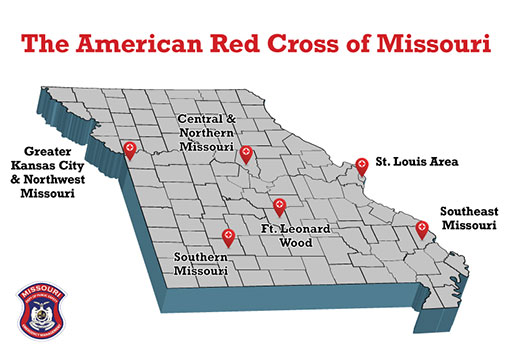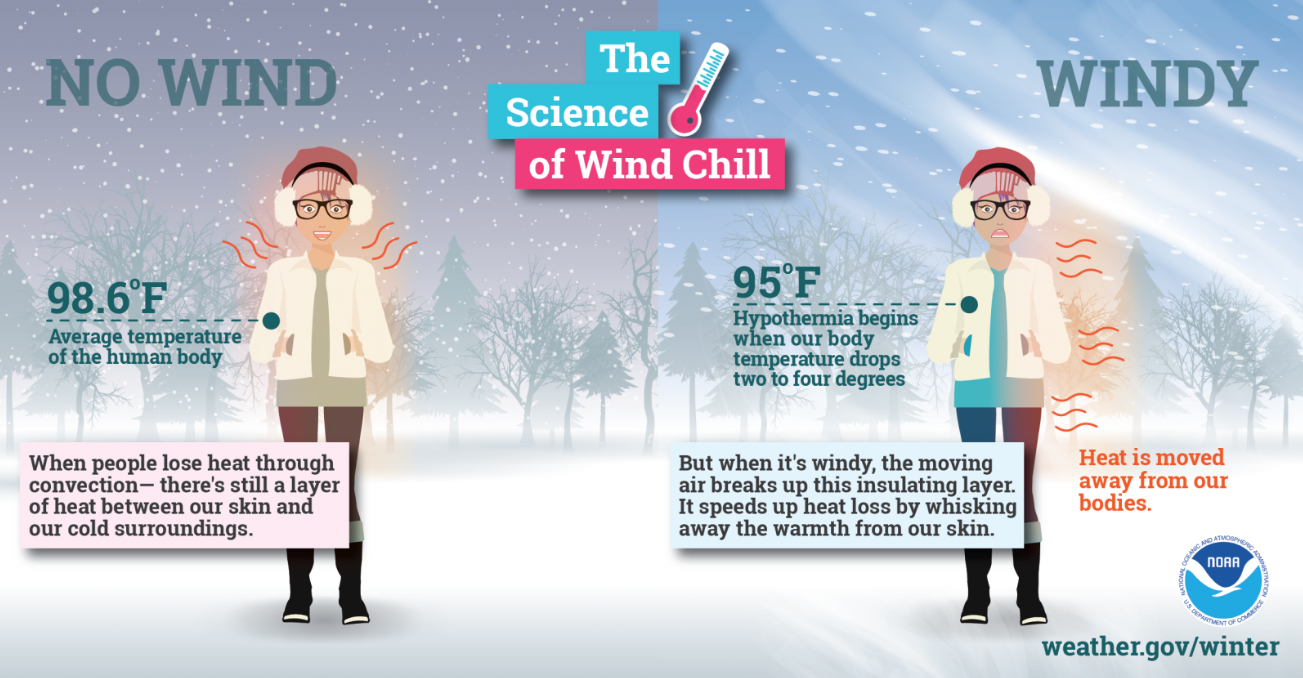Severe Winter Weather
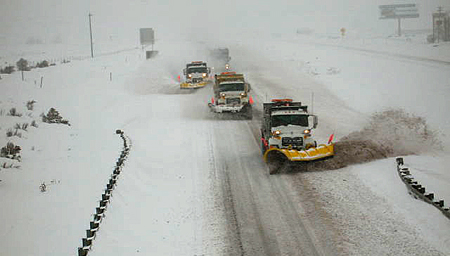 In addition to cold temperatures and snow and ice, winter brings dangerous driving conditions and the potential for damaging and deadly storms. Severe winter storms can be extremely dangerous. Transportation can come to a standstill and electricity can be out for days, often with very cold temperatures. Making preparations in advance of a storm can make getting through it easier. In 2023, 37 people reportedly died as a result of low body temperatures due to prolonged exposure to cold weather, according to the Missouri Department of Health and Senior Services. The National Weather Service, the Missouri Department of Health and Senior Services, the State Emergency Management Agency and Missouri’s local emergency managers team up each fall to promote Winter Weather Preparedness Week in Missouri. The idea is to encourage Missourians to think about safety and the safety measures they can take in advance.
In addition to cold temperatures and snow and ice, winter brings dangerous driving conditions and the potential for damaging and deadly storms. Severe winter storms can be extremely dangerous. Transportation can come to a standstill and electricity can be out for days, often with very cold temperatures. Making preparations in advance of a storm can make getting through it easier. In 2023, 37 people reportedly died as a result of low body temperatures due to prolonged exposure to cold weather, according to the Missouri Department of Health and Senior Services. The National Weather Service, the Missouri Department of Health and Senior Services, the State Emergency Management Agency and Missouri’s local emergency managers team up each fall to promote Winter Weather Preparedness Week in Missouri. The idea is to encourage Missourians to think about safety and the safety measures they can take in advance.
Preparedness tips before a Severe Winter Storm
Familiarize yourself with these terms to help identify a winter storm hazard:
- Winter Storm Watch indicates that severe winter weather may affect your area within 12-48 hours.
- Winter Storm Warning indicates severe winter weather is in the area or expected immediately and can be life threatening.
- Ice Storm Warning is issued for ice accumulations of a quarter-inch or more.
- Blizzard Warning is issued when sustained winds or frequent gusts to 35 miles per hour or greater and considerable amounts of falling or blowing snow (reducing visibility to less than a quarter mile) are expected to prevail for a period of three hours or longer.
- Frost/Freeze Warning is issued when below freezing temperatures are expected.
- Freezing Rain is rain that freezes when it hits the ground, creating a coating of ice on roads, walkways, trees, and power lines.
- Sleet is rain that turns to ice pellets before reaching the ground.
Missourians can prepare for winter by:
- Creating a family emergency plan and creating an emergency kit with bottled water and canned and dried food that can be prepared without cooking in case of a power outage.
- Adding the following supplies to your disaster supply kit: rock salt to melt ice on walkways; sand to improve traction; snow shovels and other snow removal equipment.
- Securing an alternate fuel source such as firewood or a generator. Make sure your fireplace functions properly. If you have a generator, make sure you have fuel and that it functions properly. Only operate the generator outdoors. Keep a fire extinguisher on hand.
- Creating a winter car kit in the trunk of the car. This includes: windshield scraper and small broom, flashlight, blanket, spare radio with batteries, snacks or energy-type food, water, jumper cables, flares and matches, shovel, sand or shingles to give tires traction, extra hats, socks and mittens, first aid kit, fluorescent distress flag.
- Learning how to shut off water valves in case a pipe bursts.
What to do during a severe winter storm
- Listen to radio, television, or NOAA Weather Radio for weather reports and emergency information.
- Wear several layers of loose fitting, lightweight warm clothing rather than one layer of heavy clothing. The outer garments should be tightly woven and water repellent. Wear mittens, which are warmer than gloves. Wear a hat. Cover your mouth with a scarf to protect your lungs. Protect your lungs from extremely cold air by covering your mouth when outdoors. Try not to speak unless absolutely necessary. Keep dry. Change wet clothing frequently to prevent a loss of body heat. Wet clothing loses all of its insulating value and transmits heat rapidly. Watch for signs of frostbite. These include loss of feeling and white or pale appearance in extremities such as fingers, toes, ear lobes, and the tip of the nose. If symptoms are detected, get medical help immediately. Watch for signs of hypothermia. These include uncontrollable shivering, memory loss, disorientation, incoherence, slurred speech, drowsiness, and apparent exhaustion.
- Avoid overexertion when shoveling snow. Overexertion can bring on a heart attack—a major cause of death in the winter. If you must shovel snow, stretch before going outside and take frequent breaks.
- Drive only if absolutely necessary. If you must drive, consider the following: Check the Missouri Department of Transportation’s Web site for road conditions: www.modot.mo.gov or call the Missouri Road Condition Report line at 888-ASK-MoDOT (275-6636). Travel in the day, don’t travel alone, and keep others informed of your schedule. Stay on main roads, avoid back road shortcuts. If you need assistance while on the road, or need to report and accident, broken down car, or vehicle off the road, call the Missouri State Highway Patrol’s Emergency report line by dialing *55 on your cell phone. It connects you to the nearest MSHP troop headquarters. From a land line call (800) 525-5555.
- If a blizzard traps you in the car: Pull off the highway, turn on hazard lights and hang a distress flag from the radio antenna or window. Remain in your vehicle where rescuers are most likely to find you. Do not set out on foot unless you can see a building close by where you know you can take shelter. Be careful: distances are distorted by blowing snow. A building may seem close, but be too far to walk to in deep snow. Run the engine and heater about 10 minutes each hour to keep warm. When the engine is running, open an upwind window slightly for ventilation and periodically clear snow from the exhaust pipe. This will protect you from possible carbon monoxide poisoning. In extreme cold, use road maps, seat covers, and floor mats for insulation. Huddle with others in the vehicle and use your coat for a blanket. Take turns sleeping. One person should be awake at all times to look for rescue crews. Drink fluids to avoid dehydration. Be careful not to waste battery power. Balance electrical energy needs - the use of lights, heat, and radio - with supply. Turn on the inside light at night so work crews or rescuers can see you. If stranded in a remote area, stomp large block letters in an open area, spelling out HELP or SOS and line with rocks or tree limbs to attract the attention of rescue personnel who may be surveying the area in the air. Leave the car and proceed on foot - if necessary - once the blizzard passes.
- If you do not have heat in your residence temporarily close off some rooms and remain in one area of the residence. Maintain ventilation when using kerosene heaters to avoid a build-up of toxic fumes. Refuel kerosene heaters outside and keep them at least three feet from flammable objects. Eat regularly and drink ample fluids, but avoid caffeine and alcohol. If the pipes freeze, remove any insulation or layers of newspapers and wrap pipes in rags. Completely open all faucets and pour hot water over the pipes, starting where they were most exposed to the cold (or where the cold was most likely to penetrate).
What to do if you have unmet needs following a severe winter storm
Throughout the recovery period, it is important to monitor local radio or television reports and other media sources for information about where to get emergency housing, food, first aid, clothing, and financial assistance. The following section provides general information about the kinds of assistance that may be available.
Direct Assistance
Direct assistance to individuals and families may come from any number of organizations, including:

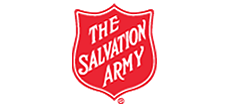

Missouri chapters of the Red Cross:
- Greater St. Louis
- Central and Northern Missouri
- Southeast Missouri
- Greater Kansas City and Northwest Missouri
- Southern Missouri
- Ft. Leonard Wood
Other volunteer and faith-based organizations
These organizations provide food, shelter, supplies and assist in clean-up efforts.
Detailed additional information can be found at the following websites:
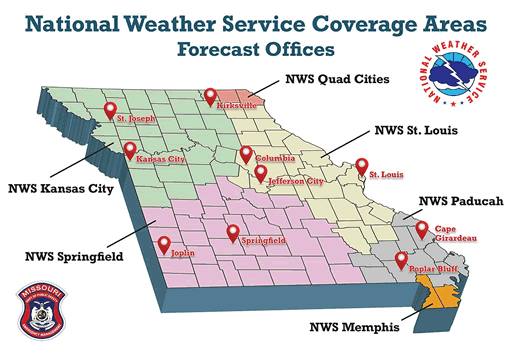
- National Weather Service – St. Louis Office
- National Weather Service – Kansas City Office
- National Weather Service – Springfield Office
- National Weather Service – Paducah Office
- National Weather Service – Memphis Office
- National Weather Service – Quad Cities Office
Missouri's Ready in 3 Program also provides free family safety guides to help prepare your family and household or call (573) 526-4768 to order a free family safety guide. The family safety guide is available in several languages.
Additional long-term preparations
- Prepare for possible isolation in your home by having sufficient heating fuel; regular fuel sources may be cut off. For example, store a good supply of dry, seasoned wood for your fireplace or wood-burning stove.
- Winterize your home to extend the life of your fuel supply by insulating walls and attics, caulking and weather-stripping doors and windows, and installing storm windows or covering windows with plastic. Make sure fireplaces and generators function properly.
- Winterize your house, barn, shed or any other structure that may provide shelter for your family, neighbors, livestock or equipment. Clear rain gutters, repair roof leaks and cut away tree branches that could fall on a house or other structure during a storm.
- Insulate pipes with insulation or newspapers and plastic, and allow faucets to drip a little during cold weather to avoid freezing.
- Keep fire extinguishers on hand, and make sure everyone in your house knows how to use them. House fires pose an additional risk, as more people turn to alternate heating sources without taking the necessary safety precautions.
- Know ahead of time what you should do to help elderly or disabled friends, neighbors or employees.
- Hire a contractor to check the structural integrity of the roof to sustain unusually heavy weight from the accumulation of snow - or water, if drains on flat roofs do not work.
- Check or have a mechanic check the following items on your car:
- Antifreeze levels - ensure they are sufficient to avoid freezing.
- Battery and ignition system - should be in top condition and battery terminals should be clean.
- Brakes - check for wear and fluid levels.
- Exhaust system - check for leaks and crimped pipes and repair or replace as necessary. Carbon monoxide is deadly and usually gives no warning.
- Fuel and air filters - replace and keep water out of the system by using additives and maintaining a full tank of gas.
- Heater and defroster - ensure they work properly.
- Lights and flashing hazard lights - check for serviceability.
- Oil - check for level and weight. Heavier oils congeal more at low temperatures and do not lubricate as well.
- Thermostat - ensure it works properly.
- Windshield wiper equipment - repair any problems and maintain proper washer fluid level.
- Install good winter tires. Make sure tires have adequate tread. All-weather radials are usually adequate for most winter conditions. However, some jurisdictions require that to drive on their roads, vehicles must be equipped with chains or snow tires with studs.
- Maintain at least a half tank of gas during the winter season.

